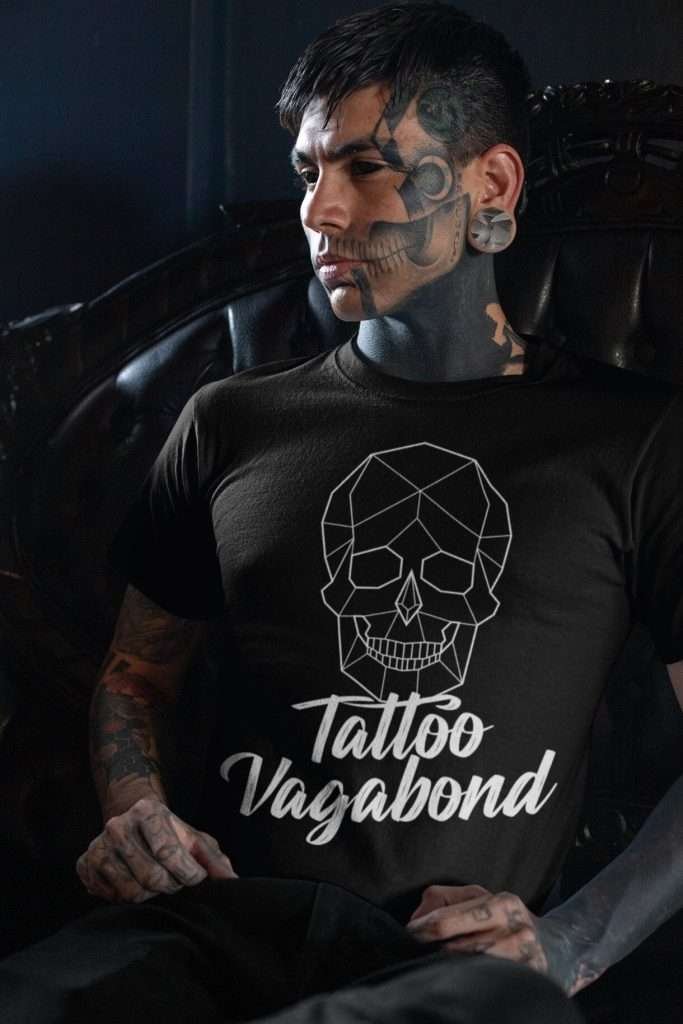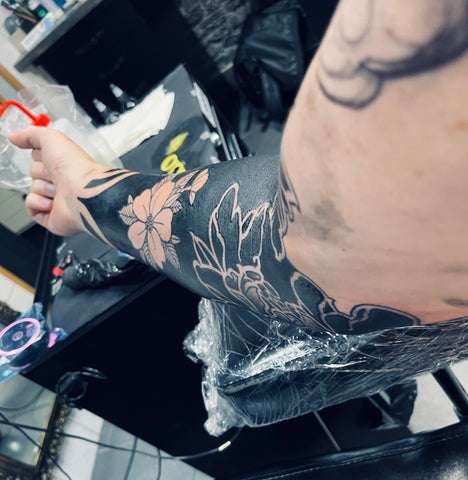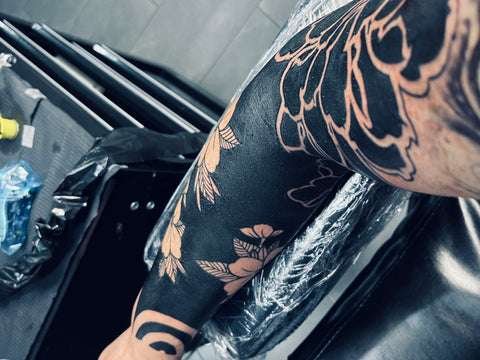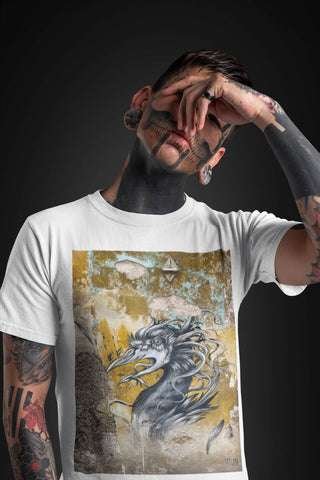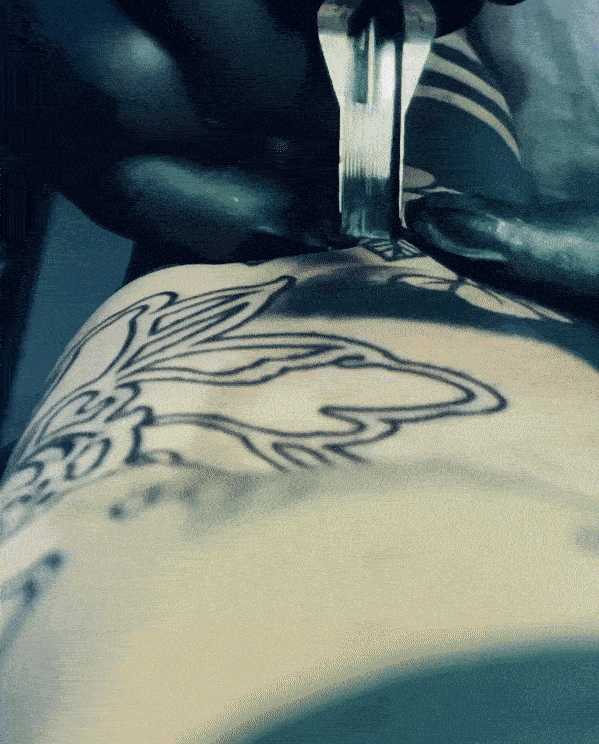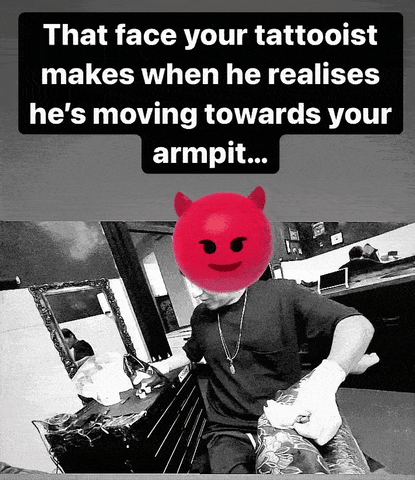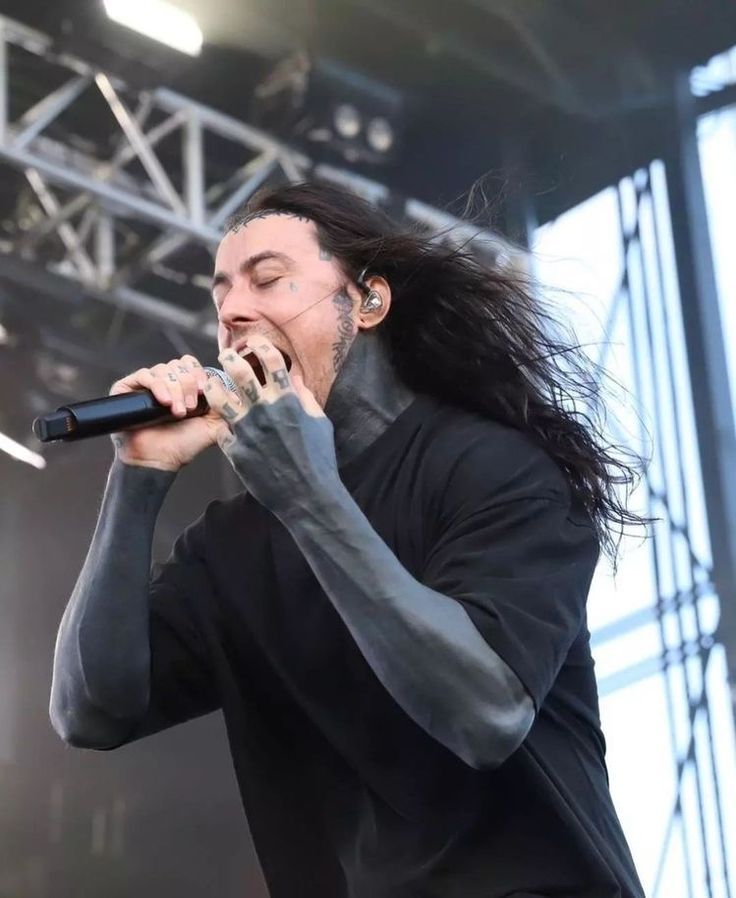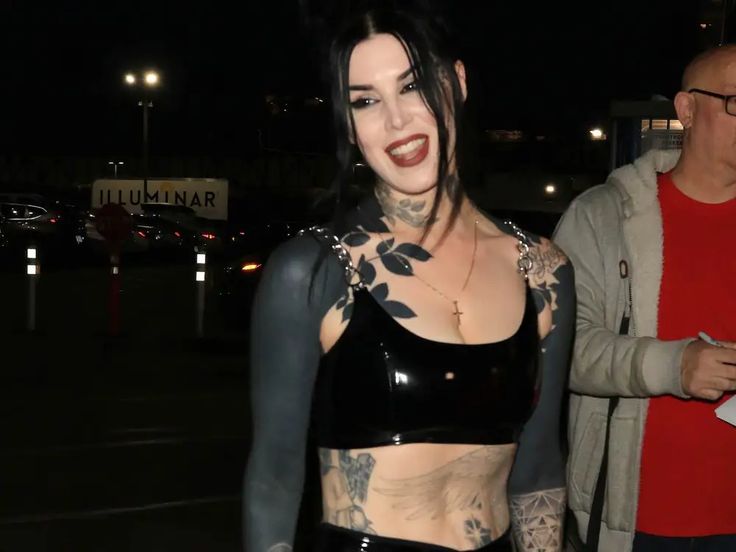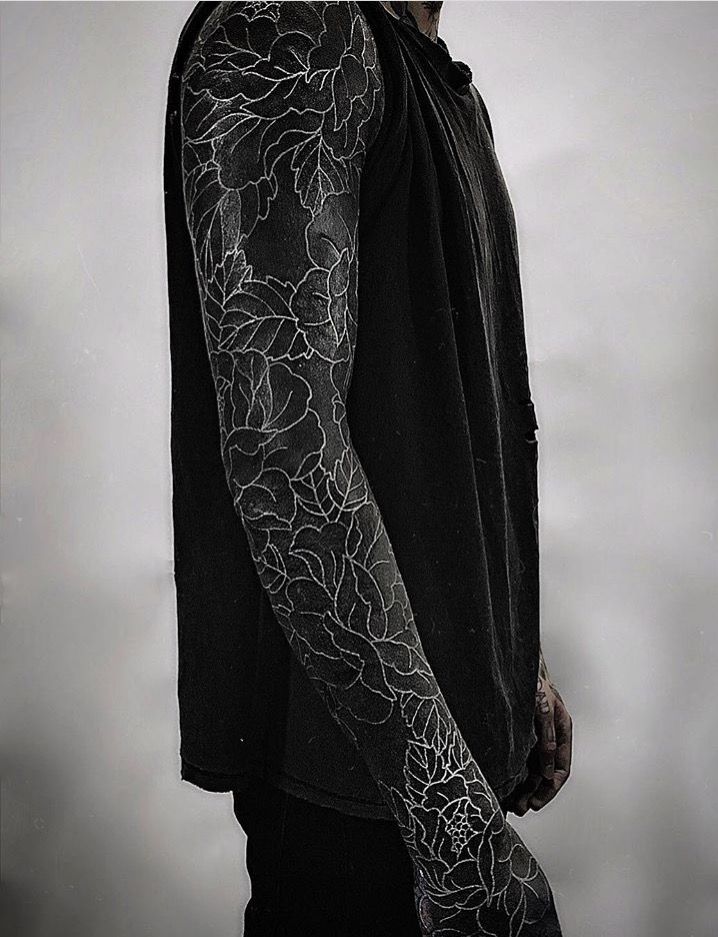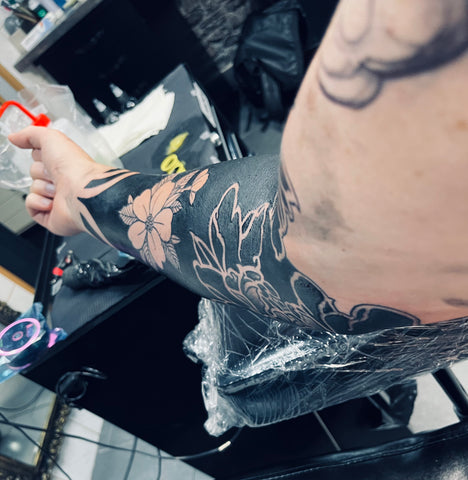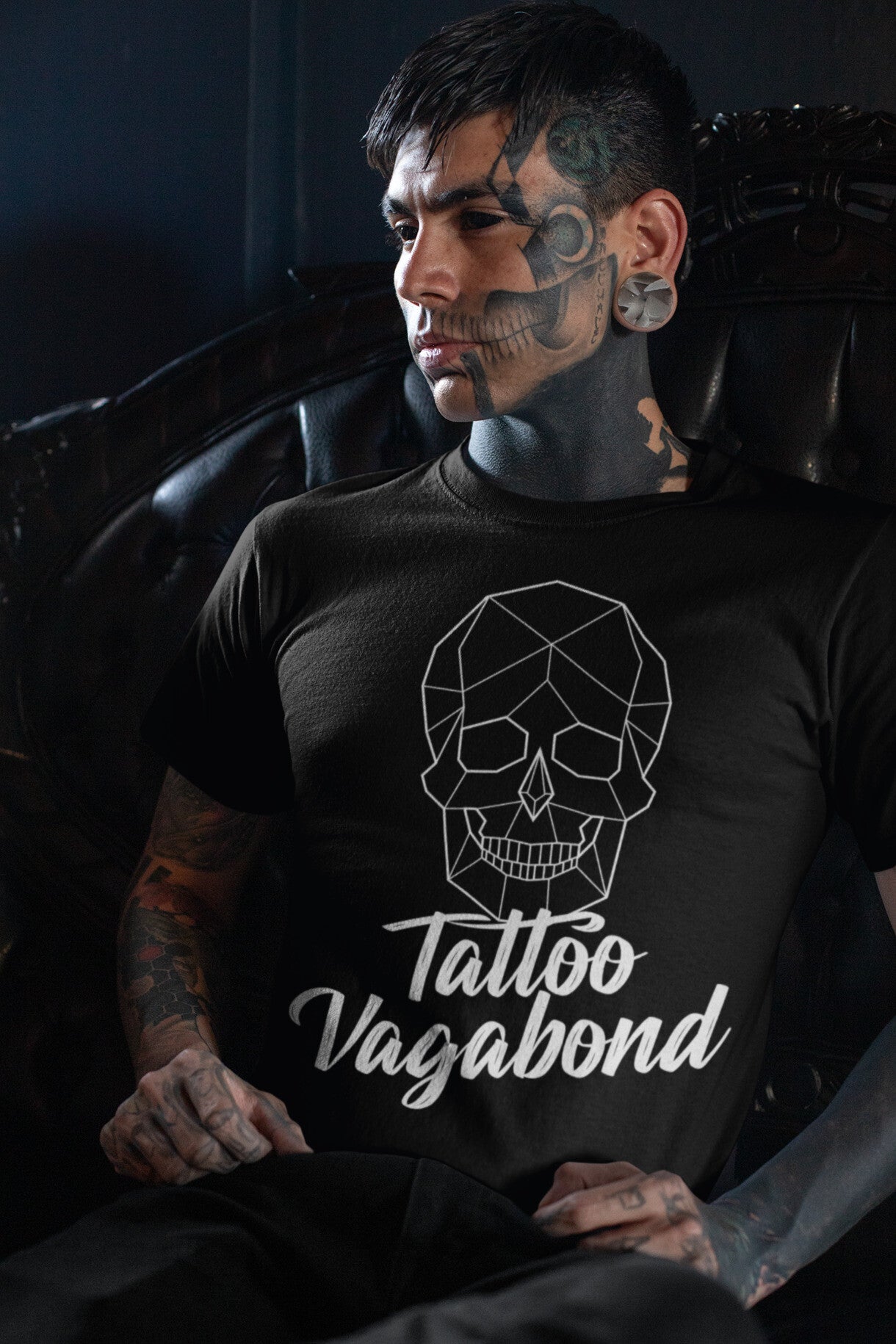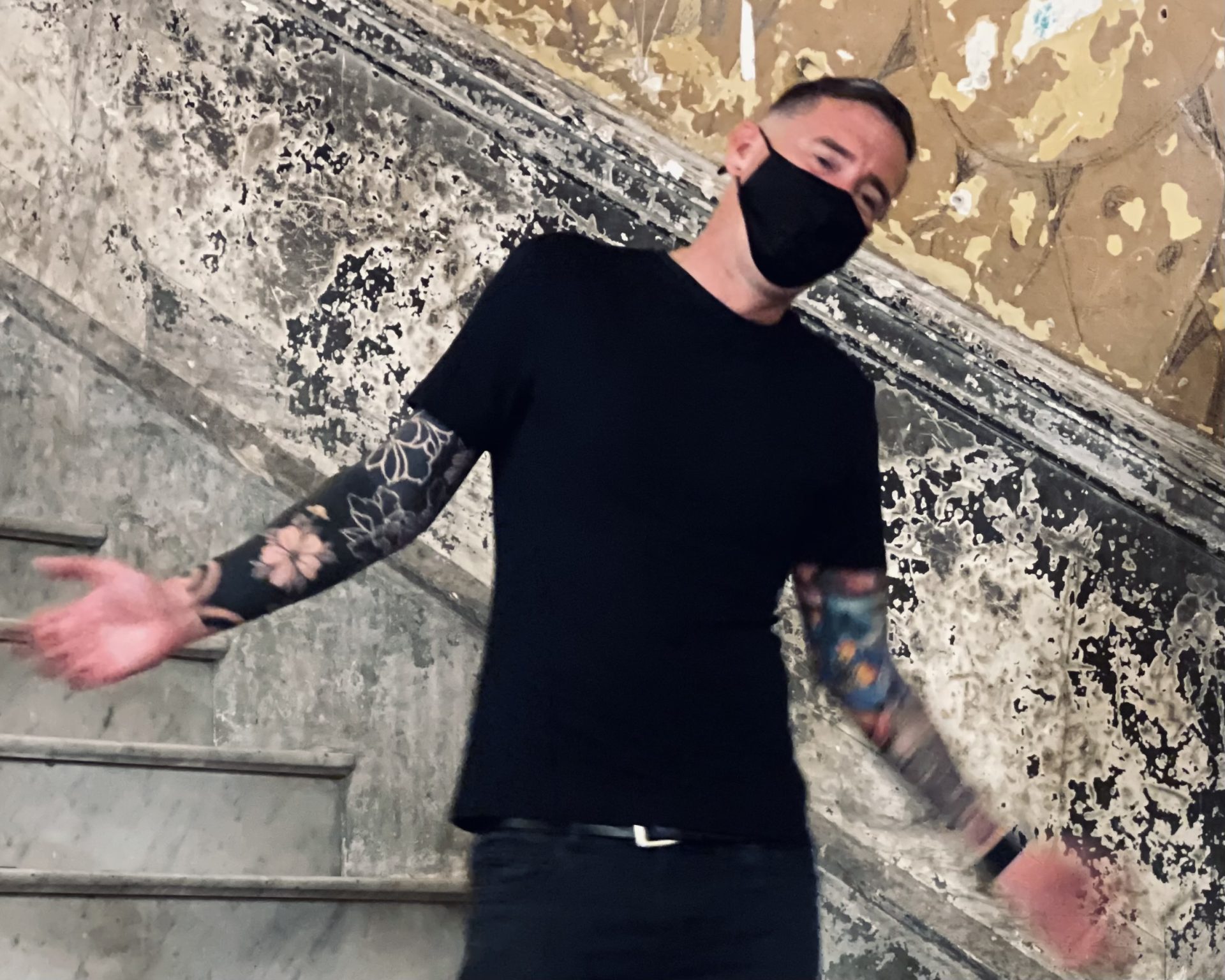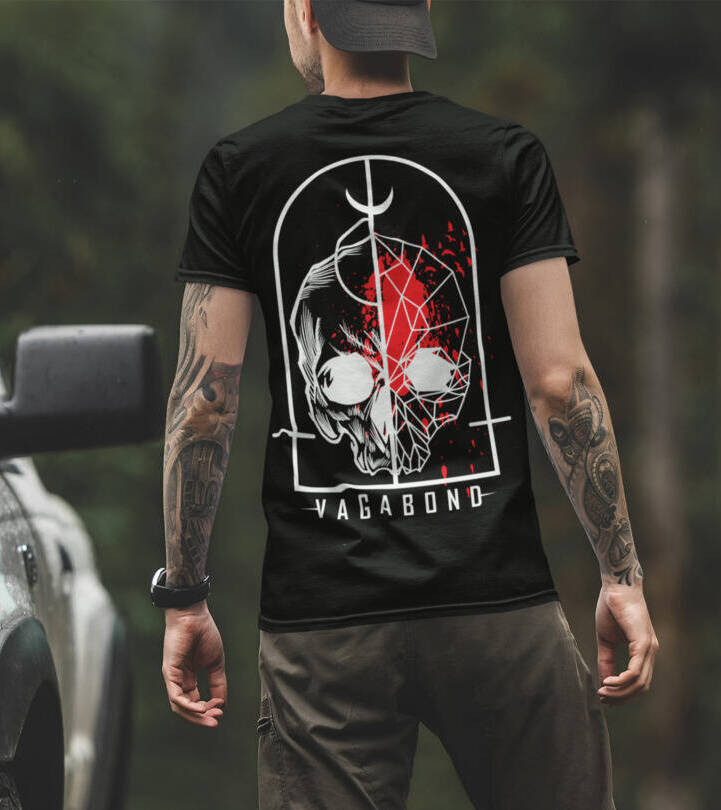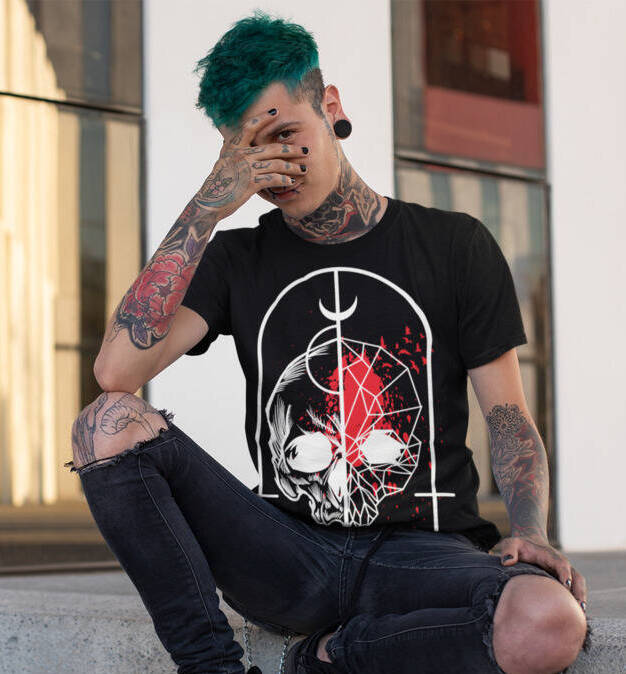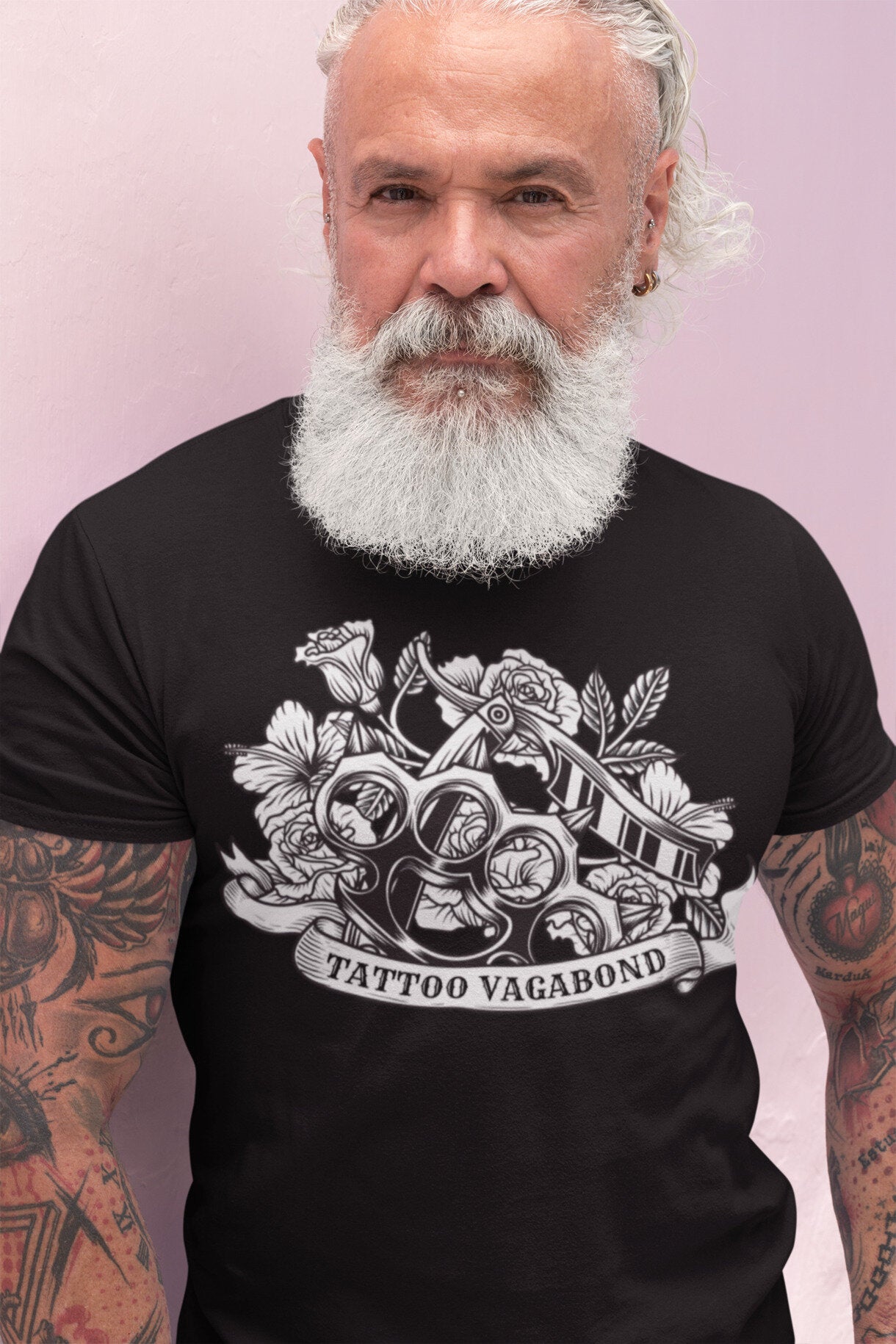There is no single reason for why people choose blackwork or why people get blackout tattoos. A blackout tattoo can be used to coverup existing tattoos or it can be a standalone statement piece. It may even be a symbol of grief and mourning.
To try and understand why people get what’s often incorrectly called a blackout tattoo, let’s first endeavor to understand what a ‘blackout tattoo’ is, and in which genre of tattooing it fits.
As someone who has both a blackout tattoo sleeve and a color tattoo sleeve, plus a degree in cultural sociology, here’s what I think you need to know about blackout tattoos.
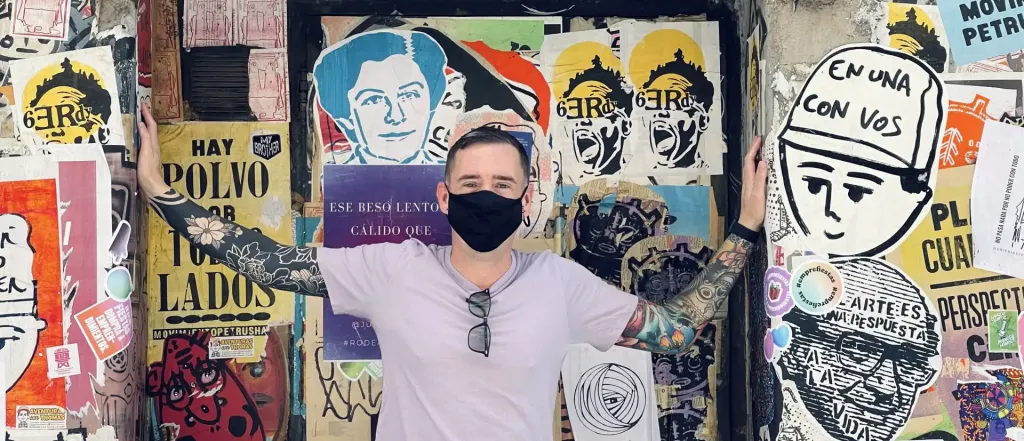
Blackout tattoo frequently asked questions (FAQ)
What are blackout tattoos?
‘Blackout’ is a generic catchall term given to any type of tattoo that involves a heavy use of black tattoo ink.
Tattoos that are termed ‘blackout’, all tend to make use of heavy blackwork. These tattoos all use a consistent application of opaque black ink over a large bodily surface. As such, ‘blackout tattoos’ all fall within the style of tattooing called blackwork.
Blackwork as a tattooing style uses solid panes of black ink to create abstract patterns and geometric shapes. Blackwork as a style of tattooing uses only black ink.
The most common placements for ‘blackout’ tattoos are the arms and legs. Though other placements are becoming more common, thanks to tattooists like Ruslan & Tonya at AbuSevTattoo. AbuSevTattoo also make a lot of the specialized equipment used by blackwork artists.
Blackout tattoos aren’t new. Blackwork as a tattoo style is as old as tattooing itself. The use of large panes of solid black ink is common in many different cultures.
Are blackout tattoos a single style?
Blackout tattoos are not a single style or coherent standalone genre of tattoo. All blackout tattoos fall within the traditional domain of ‘blackwork’.
The larger and more bold the use of black is, the more likely it is to be labeled as a ‘blackout tattoo’ on social media.
Yet, there are many different styles or sub-genres of blackwork tattoos that all make heavy use of black ink. And these are all lumped together and often mistakenly called ‘blackout tattoos’.
What are some types of ‘blackout’ tattoos?
Two types of blackout tattoos that stand out are large negative space tattoo designs and large geometric blackwork. Though larger tribal or neo-tribal tattoo designs also seem to be making it into the ‘blackout tattoo’ catchall on social media these days.
Pretty much, if a tattoo is large and uses a single solid shade of black, it’s likely labeled as a ‘blackout tattoo’ on social media.
How are blackout tattoos done?
Tattoos labeled as ‘blackout tattoos’ will involve tattooing a large area of the body using only black ink. Typically the arms or legs.
The application of dark black ink is consistent across the designs. And shading isn’t used in ‘blackout’ designs. Just take a look at these blackwork and black tattoo ideas.
Can you tattoo over blackout tattoos?
You can tattoo over blackwork. One stylistic element of blackout tattooing that is rising in popularity is the use of white ink over larger blackwork designs.
Blackout tattoo sleeves with white ink, are rising in popularity thanks to social media. And the use of white ink over a large ‘blackout sleeve’ can allow for the creation of subtle designs with a striking contrast.
Colors other than white ink won’t work well over a black tattoo. So, if you desire a colored tattoo, you will first need to have the black tattoo removed.
Why do people get blackout tattoos?
There is no single reason for why people choose blackwork or why people get blackout tattoos. A blackout tattoo can be used to coverup existing tattoos or it can be a standalone statement piece.
Blackwork in general has less intricate details and no shading. And blackwork tattoos will likely resist aging and fading far better than most other styles of tattooing.
It’s important not to label all blackwork that uses large panes of black ink as a ‘blackout tattoo’ and assume that the work is a coverup.
The majority of the tattoos seen on social media that are labeled as blackout tattoos are not coverups of older tattoos. The majority of the tattoos labeled as ‘blackout tattoos’ are standalone tattoo pieces. They aren’t coverups.
Why did I choose to get a ‘blackout tattoo’?
My black tattoo sleeve is a negative space design. It’s often referred to as a negative space blackout tattoo. Yet it will soon have the addition of white ink tattooed over the black sleeve in parts of the design.
I had my artist design this black tattoo sleeve for me. It contrasts with my colored tattoo sleeve and was created as sign of loss and mourning.
In western cultures, a black armband is often worn as a symbol that the wearer is in mourning. And this meaning translates across into tattoos.
Historically, a solid black armband tattoo represents the loss of a loved one. In western cultures, black is the color of death and mourning. And my black tattoo sleeve represents or symbolizes, the act of carrying with me the memory of the deceased. It’s a more permanent black armband.
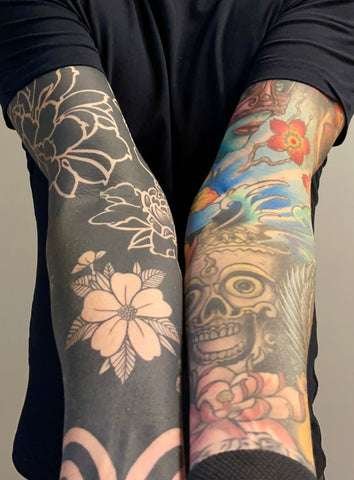
Blackout Tattoos FAQ
Why are blackout tattoos a thing?
The popularity of blackout tattoos can be partly attributed to social media. And partly to the overall rise in popularity of tattoos in general.
Like the celebrities below, for some people tattoo removal is not a viable option when they want to change their style or when they get sick of the tattoos they already have. So, they opt for blackout tattoos as a coverup option.
For others like me, we opt for blackouts as a first pass tattoo and not a coverup. And we get blackout tattoos for a particular significance and meaning. My own negative space abstract blackout sleeve signifies both mourning and loss. It’s a more permanent black arm band.
Will I regret my blackout tattoo?
I’ve had my blackout tattoo sleeve for almost 5 years and I don’t regret getting it. Read this article to see why I don’t regret my blackout tattoo.
Are blackout tattoos dangerous or are blackout tattoos bad for you?
No, blackout tattoos are not dangerous and they are not bad for you. Blackout tattoos are safe, provided you are using regulated inks and you are getting tattooed by a qualified professional tattoo artist.
Professional tattoo artists will adhere to proper sterilization and safety protocols. And black inks on the market today are often the least likely to cause allergic reactions or adverse events.
Are blackout tattoos more difficult for tattoo artists?
Blackout tattoos are not more difficult for a tattoo artist to produce. Blackout tattoos are easier and less time consuming for your tattooist. And no reputable tattooist will tell you that a blackout tattoo is more difficult or time consuming.
My own blackout sleeve was completed in half the time it took to produce my colored sleeve. And both my color sleeve and my blackout tattoo sleeve, were produced by the same tattoo artist.

Do blackout tattoos take longer to heal?
Blackout tattoos do not take longer to heal. In all types of tattoos and with all colors of ink including black, the tattoo ink is injected at a depth of 1-2mm into the second layer of skin called the dermis. A solid color tattoo and a solid black tattoo are identical in terms of process and healing times.
Note: Tattoo aftercare is important for large blackout tattoos, because your artist will typically cover a larger area during each tattoo session.
Do blackout tattoos hurt more or cause more pain?
A blackout tattoo does not hurt more to get than a colored tattoo. In fact, as someone who has both a colored sleeve and a blackout sleeve, I can say from experience that the colored sleeve hurt more.
A colored tattoo will require more passes over the area to get the desired color saturation. A colored tattoo takes longer to get right and hurts more than a blackout tattoo. But if you’re worried about pain, use a tattoo numbing product.
Do blackout tattoos cost more to get?
Tattoo prices are determined by the amount of consumables used and the number of hours required of the artists time. Blackout tattoos use less consumables and require less time to produce. Blackout tattoos cost less than a detailed colored tattoo of a similar size.
My own blackout sleeve was roughly half the price of my colored sleeve. And both were completed by the same tattoo artist.
Are blackout tattoos a form of cultural appropriation?
I have 8 university degrees and one of them is a bachelor of cultural sociology. As someone with a degree in cultural sociology and a blackout sleeve, I can say that no, blackout tattoos are not a form of cultural appropriation.
Are blackout tattoos racist?
On the whole, no. Blackout tattoos are not racist and do not signify any form of racism or racist ideology. With that said, there are some blackout tattoo placements that should never be considered.
For example, facial blackouts are highly problematic and can be mistaken for ‘blackface’, whether the wearer intends to or not. You should never get a blackout tattoo on your face. A blackout face tattoo is ‘blackface’, whether or not you intend it to be. And a blackout face tattoo can be both offensive and racist.
Are blackout tattoos more difficult to remove?
Blackout tattoos are not more difficult or more expensive to remove. The only FDA approved method of tattoo removal is laser removal. And black is one of the easiest colors for laser removal technologies to break down and remove. The main determining factor for most tattoos will be the size and placement.
Do blackout tattoos make skin cancer screening more difficult?
As an Australian, skin cancer checkups are a necessary part of any visit to the doctor. And my tattoos do make checking parts of my body nearly impossible for my own doctor. But my blackout tattoo is not more or less difficult to check.
Both my colored tattoo sleeve and my blackout sleeve, are virtually impossible for my doctor to check for skin cancers like melanoma. My blackout tattoo is not more or less difficult to check for skin cancers. And my doctor tells me he can’t check either arm properly.
Because a tattoo with solid panes of black or colored ink can’t be properly checked for skin cancer, it’s crucial to wear sunscreen when out in the sun. With any tattoo that makes use of solid panes of either colored ink or solid black ink, wearing sunscreen is a necessity.
Are blackout tattoos more likely to cause an allergic reaction to tattoo ink?
Blackout tattoos are not more or less likely to cause an allergic reaction to tattoo ink. Whether or not you will have an allergic reaction to tattoo ink, is determined by the brand of ink used, the color and your own body.
In point of fact, some colors like red are more likely to contain allergenic ingredients and cause allergic reactions. To avoid possible long term complications, always use a reputable tattoo artist and regulated inks.
Note: Blackout tattoos do require proper aftercare in order to ensure there are no unwanted complications. And this is due to their size and the area covered by your tattooist during each tattoo session.
Why do tattoo artists blackout their tattoo sleeves?
For most tattooists, their arms are the first tattoos they acquire. And often, tattoo artists will practice on themselves during their apprenticeship. This means that their least favorite tattoos are often their arm and leg sleeves.
Like the celebrities below, tattoo removal is not often a viable option for tattoo artists. And this is due to the size and coverage of their tattoos. So, when a tattoo artist wants to remove or coverup their existing sleeves, blackout tattoos are often the better choice.
Why did Ronnie Radke get a blackout?
When you have as much ink as someone like Ronnie Radke, tattoo removal becomes the least desirable option if you want to change your style and aesthetic. Tattoo removal is costly and painful, with a long down time for recovery.
If you’re covered head to toe in ink and want to change your tattoos, having them removed and then re-tattooing the area is extremely painful, expensive and time consuming. In such a case, blackwork coverups and blackout tattoos are often the more appealing option. When Ronnie Radke wanted to change his style and aesthetic, blackout tattoos were likely his best option.
Why did Kat Von D get a blackout tattoo?
Like Ronnie Radke, laser removal wasn’t realistic to use in Kat Von D‘s case. And she admired the sleek black aesthetic of blackout tattoos. So, Kat Von D opted for a blackout tattoo to cover-up her old ink.
Why did Oli Sykes blackout his arm?
Oli Sykes was married to tattoo artist Hannah Pixie Snowdon. And at the time, he blacked out his right arm so that Snowdon could add her own mark to his tattoo collection. Sykes has a full blackout sleeve with white ink overlay.
Why did Machine Gun Kelly (MGK) get a blackout tattoo?
Like both Ronnie Radke and Kat Von D, Machine Gun Kelly already had extensive tattoos and wanted to change his aesthetic. And for MGK tattoo removal wasn’t a viable option. As the down time for recovery and the pain involved, would have been excessive. So, instead, MGK opted for a stunning blackwork coverup by ROXX.
And before the haters flood in no, it’s not ‘cultural appropriation’. But yes, it would have been extremely painful. Particularly around the ‘pectoralis major tendon‘, where the pec meets the shoulder. MGK would have used a recommended numbing cream.
